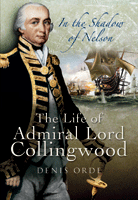Many “great captains” in military history were well served by distinguished lieutenants, and Lord Horatio Nelson was certainly one of them. Denis Orde, author of Nelson's Mediterranean Command, now turns to one of the quintessential British admiral's closest friends and contemporaries, Vice Admiral Cuthbert “Cuddy” Collingwood, for whom the book's title, In the Shadow of Nelson, still applies—both figuratively and literally.
Although they had been friends since first meeting as young midshipmen in 1773, the then-23-year-old Collingwood, 10 years Nelson's senior, possessed a different type of character than Nelson's. Collingwood had his first taste of combat success in the American War of Independence, leading a detachment of marines during the Battle of Bunker Hill on June 17, 1775. In April 1780 he took command of the frigate Hinchinbroke—in place of a seriously ailing Nelson, in the wake of a disastrous expedition to the Mosquito Coast of Spanish-held Nicaragua. Collingwood did what he could by washing down the lower decks with vinegar, fumigating to keep the mosquitoes at bay and erecting structures offshore for the hospitalization of the sick. Even so, of Hinchinbroke's 200-man crew he buried 180. Although the expedition was a failure, it deepened the relationship between Nelson and Collingwood.
Orde's narrative follows the two friends in West Indies, Nelson as commander of HMS Boreas, Collingwood commanding Mediator and his younger brother Wilfred commanding the 16-gun brig-sloop Rattler. It was Wilfred who influenced Nelson to activate the old Navigation Acts in Barbados against ships flying the new flag of the United States. Aside from politics, Nelson and Collingwood developed something of an infatuation for Mrs. Mary Mourtray, the wife of the Resident Commissioner of the Naval Dockyard at English Harbour Antigua. From that “affair” two drawings made at the time, by Collingwood of Nelson and by Nelson of Collingwood, survive and can now be seen in the National Maritime Museum at Greenwich.
Orde focuses special attention on the three great naval battles in which Collingwood best displayed his capabilities, especially in gunnery. At the first, known as the “Glorious First of June” in 1794, Captain Collingwood took charge after Rear Adm. George Bowyer's leg was shot off aboard the 98-gun ship of the line Barfleur.
The second battle, Cape St. Vincent, 14 February 14, 1797, saw Collingwood, commanding HMS Excellent, follow Nelson's Captain in his famous maneuver against the Spanish fleet.
The third battle, was of course, was Trafalgar on October 21, 1805, in which Collingwood, commanding the first column aboard Royal Sovereign, succeeded in separating the French and Spanish fleets.
Denis Orde gives us Collingwood's human and well as intellectual side. While flogging was the common everyday punishment aboard Nelson's flagship Victory, Collingwood generally avoided resorting to that type of punishment. After Trafalgar he ordered the wounded Spanish prisoners returned home. At a time when the majority of British captains were men of action rather than of letters, he wrote the famous dispatch to his majesty King George III that spoke of Nelson as an “immortal memory,” a phrase by which he is remembered.
After his death on March 7, 1810, Collingwood was buried in the shadow of Nelson's tomb at St. Paul's Cathedral—as in life, so in death. Given the nature of its subject, In the Shadow of Nelson gives more than just the life and times of a naval hero. Readers interested in knowing how Great Britain became the most powerful naval power of the 19th century will also find the book an enlightening general survey of the Royal Navy he served from 1770 to 1810.
Review by Thomas Zacharis (ed. H.D.W.)
In the Shadow of Nelson: The Life of Admiral Lord Collingwood
Author(s) : ORDE Denis

- Year of publication :
- 2008
- Place and publisher :
- Pen and Sword Books
- Number of pages :
- 180

